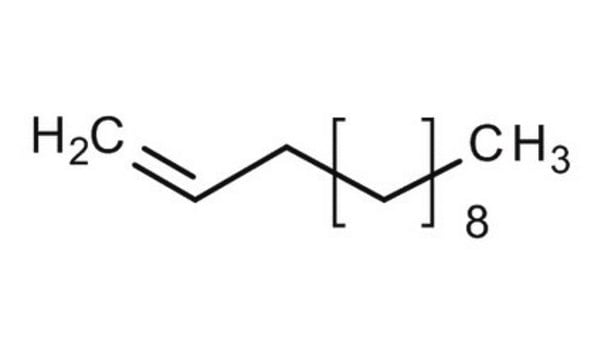About This Item
Recommended Products
vapor density
4.84 (vs air)
vapor pressure
1.6 mmHg ( 23.8 °C)
Assay
94%
form
liquid
autoignition temp.
455 °F
impurities
≤2.0% 2-butyl-1-hexene
≤2.0% 2-ethyl-1-octene
≤2.0% n-decane
refractive index
n20/D 1.421 (lit.)
bp
166.5-173.5 °C (lit.)
mp
−66.3-−66 °C (lit.)
density
0.741 g/mL at 25 °C (lit.)
SMILES string
CCCCCCCCC=C
InChI
1S/C10H20/c1-3-5-7-9-10-8-6-4-2/h3H,1,4-10H2,2H3
InChI key
AFFLGGQVNFXPEV-UHFFFAOYSA-N
Looking for similar products? Visit Product Comparison Guide
General description
Application
- Polymerization Catalyst Research with 1-Decene: A study on high molecular weight copolymers incorporating 1-Decene highlights advanced polymerization techniques using Lewis acid catalysts, essential for producing materials with specific mechanical properties (Wan et al., 2024).
- 1-Decene in Biodegradable Polymer Development: Research into the molecular dynamics of 1-Decene oligomers assesses their suitability in the synthesis of high-performance, biodegradable polymers, contributing to more sustainable material solutions (Mercier Franco and Firoozabadi, 2023).
- 1-Decene as a Precursor in Surfactant Production: An examination of the thermophysical properties of long linear and branched alkanes, including 1-Decene, provides insights into their potential as precursors for surfactant production, crucial for chemical engineering applications (Schmitt et al., 2023).
Signal Word
Danger
Hazard Statements
Precautionary Statements
Hazard Classifications
Aquatic Acute 1 - Aquatic Chronic 1 - Asp. Tox. 1 - Flam. Liq. 3
Storage Class Code
3 - Flammable liquids
WGK
WGK 3
Flash Point(F)
111.2 °F - closed cup
Flash Point(C)
44.0 °C - closed cup
Personal Protective Equipment
Certificates of Analysis (COA)
Search for Certificates of Analysis (COA) by entering the products Lot/Batch Number. Lot and Batch Numbers can be found on a product’s label following the words ‘Lot’ or ‘Batch’.
Already Own This Product?
Find documentation for the products that you have recently purchased in the Document Library.
Customers Also Viewed
Our team of scientists has experience in all areas of research including Life Science, Material Science, Chemical Synthesis, Chromatography, Analytical and many others.
Contact Technical Service












